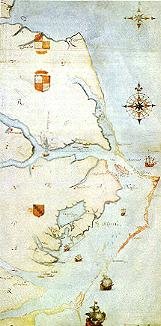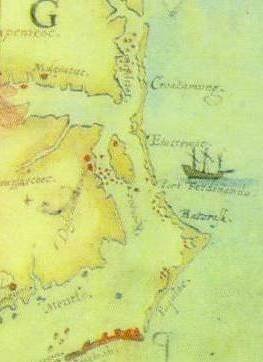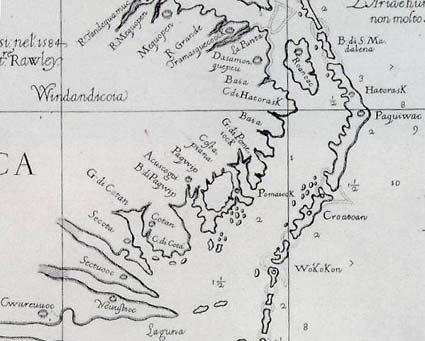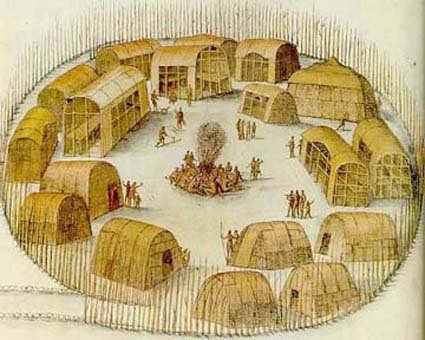Priscilla: The story of an African slave
|
| |||
Cont:
http://news.bbc.co.uk/2/hi/africa/4460964.stm
This blog is © History Chasers
Click here to view all recent Lost Colony Research Group Blog posts
~ History ~ Genealogy ~ Archaeology ~
Priscilla: The story of an African slave
|
| |||
Posted by
Historical Melungeons
at
2/17/2012 04:27:00 PM
![]()
Labels: africa, Genealogy, Sierra Leone, slave, South Carolina
On July 15th, 2009, Time Team America visits one of the most controversial sites in North America: the Topper site, which is believed by its excavator to contain a 20,000-50,000 year old preclovis site.
Waters, Michael R., Steven L. Forman, Thomas W. Stafford Jr., and John Foss 2009 Geoarchaeological Investigations at the Topper and Big Pine Sites, Allendale County, Central Savannah River, South Carolina. Journal of Archaeological Science 36(7):1300-1311. As far as I'm aware, this is the only peer-reviewed paper on Topper published to date. It details the stratigraphy and presents a suite of AMS and thermoluminescence dates for it; but concludes that the human origin of the "smashed core and microliths" preclovis occupation has not been proven.
Populating America: Four Theories
Posted by
Historical Melungeons
at
7/14/2009 06:23:00 PM
![]()
Labels: Algonquian Indians, artifacts, humans, indigeous, South Carolina, stalling, topper
We hear that hurricanes are growing worse, but that idea does not hold up under scrutiny. In fact a new technique is showing just the opposite. One can only imagine the horrors visited upon the Indians living there at the time.
According to this book; Hurricanes and Typhoons: Past, Present, and Future
by Richard J. Murnane (Editor), Kam-biu Liu (Editor)
"Paleotempestology is an emerging field of science that studies past tropical cyclone activity mainly through the use of geological proxy techniques..."
A study of the past 5,000 years reveals the past 1.000 years to have been relatively quiet.
http://www.amazon.com/reader/0231123884?_encoding=UTF8&ref_=sib_sip_pdp_pg&query=hurricane%20history#reader
http://www.amazon.com/reader/0231123884?_encoding=UTF8&ref_=sib_sip_pdp_pg&query=hurricane%20history#reader
© History Chasers
Click here to view all recent Searching for the Lost Colony DNA Blog posts
Posted by
Historical Melungeons
at
5/03/2009 06:39:00 PM
![]()
Labels: Algonquian Indians, eastern seaboard, georgia, hurricanes, hurricanos, mississippi, north carolina, South Carolina
When most of us were in elementary school, we learned about the English settlement at Jamestown and the Pilgrims' landing at Plymouth Rock. It seemed that all 13 American colonies were settled by people who sailed directly from the British Isles or continental Europe.
But one colony was different. Many of South Carolina's early settlers – and an even higher proportion of its leaders – came from the English colony of Barbados.
Barbados is the most eastern island in the West Indies. It lies off the northeastern coast of South America and is sandwiched between the Atlantic Ocean on its east and the Caribbean Sea on its west. At 166 square miles, Barbados is less than half the size of South Carolina's smallest county, McCormick.
British colonists first arrived in Barbados in 1627, and by 1645 there were 11,200 farms and plantations on the island. In just 18 years sugarcane had become an extraordinarily profitable crop, but one that required lots of land and slave labor.
Land, of course, was limited on Barbados, and many planters decided to sell their property and invest in the newly formed colony of Carolina, where land and the opportunities it provided seemed unlimited.
continue on SCIway
Posted by
Historical Melungeons
at
1/05/2009 09:40:00 PM
![]()
Labels: Barbados, South Carolina
Posted by
Historical Melungeons
at
10/29/2007 10:01:00 AM
![]()
Labels: Brayboy, DNA, Genetic Genealogy, lost colony, Lumbee, north carolina, sir walter raleigh, South Carolina

In the interest of a balanced viewpoint, this blog will occasionally publish op-ed articles by guest authors. These articles may not, necessarily, reflect the opinion of the editors.
Surname-Source
Allen -- Colonist roster
Alligood -- Families of Interest
Archard-- Colonist roster
Archard -- Families of Interest
Armstrong -- Families of Interest
Arthur -- Colonist roster
Austin -- Families of Interest
Bailie -- Colonist roster
Barber, Barbour -- Families of Interest
Barrow -- Families of Interest
Beasley -- Families of Interest
Bennet -- Colonist roster
Bennet -- Families of Interest
Berde -- Colonist roster
Berry -- Families of Interest
Berrye -- Colonist roster
Bishop -- Colonist roster
Blount -- Families of Interest
Borden -- Colonist roster
Boyd -- Families of Interest
Bragg -- Families of Interest
Bridger -- Colonist roster
Bridger -- Families of Interest
Bright -- Colonist roster
Bright -- Families of Interest
Brooke -- Colonist roster
Brooks -- Families of Interest
Browne -- Colonist roster
Bryant -- Families of Interest
Buck -- Families of Interest
Burden -- Colonist roster
Butler -- Colonist roster
Butler -- Families of Interest
Cage -- Colonist roster
Cahoon -- Families of Interest
Cain -- Families of Interest
Carawan -- Families of Interest
Caroon, Carron -- Families of Interest
Carrow -- Families of Interest
Chapman -- Colonist roster
Chapman -- Families of Interest
Chavis -- Families of Interest
Cherry -- Families of Interest
Cheven -- Colonist roster
Collins -- Families of Interest
Colman -- Colonist roster
Cooper -- Colonist roster
Cooper -- Families of Interest
Cotsmur -- Colonist roster
Cox -- Families of Interest
Crisp -- Families of Interest
Croom -- Families of Interest
Cuttler -- Families of Interest
Daniel -- Families of Interest
Dare -- Colonist roster
Darige -- Colonist roster
Darige -- Families of Interest
Dixon -- Families of Interest
Dorrell -- Colonist roster
Durrance -- Families of Interest
Durrant -- Families of Interest
Dutton -- Colonist roster
Earnest -- -- Colonist roster
Edwards -- Families of Interest
Elks -- Families of Interest
Ellis -- Colonist roster
Ellis -- Families of Interest
English -- Colonist roster
Evans --Families of Interest
Farre -- Colonist roster
Farrow -- Families of Interest
Fitspatric -- Families of Interest
Florrie -- Colonist roster
Forbs -- Families of Interest
Gaylord -- Families of Interest
Gibbes -- Colonist roster
Gibbs -- Families of Interest
Glane -- Colonist roster
Gramme -- Colonist roster
Griffin -- Families of Interest
Gurganus -- Families of Interest
Gurkin -- Families of Interest
Hardison -- Families of Interest
Harris -- Colonist roster
Harris -- Families of Interest
Harviem -- Colonist roster
Harvie -- Families of Interest
Harvye -- Colonist roster
Hassell --Families of Interest
Hawkins --Families of Interest
Hedgepath -- Families of Interest
Hemmington -- Colonist roster
Hewet -- Colonist roster
Hill -- Families of Interest
Hodges -- Families of Interest
Howe -- Colonist roster
Hudson -- Families of Interest
Humfrey -- Colonist roster
Hynde -- Colonist roster
Jackson -- Families of Interest
Jennette --Families of Interest
Jerkins -- Families of Interest
Johnson -- Colonist roster
Johnson -- Families of Interest
Jones -- Colonist roster
Jones -- Families of Interest
Kemme -- Colonist roster
Keys -- Families of Interest
King -- Families of Interest
Lasie -- Colonist roster
Lathan -- Families of Interest
Lawrence -- Colonist roster
Leary -- Families of Interest
Little -- Colonist roster
Long -- Families of Interest
Lowery -- Families of Interest
Lucas -- Colonist roster
Lucus -- Families of Interest
Mackey -- Families of Interest
Mann -- Families of Interest
Mannering -- Colonist roster
Martyn -- Colonist roster
Mayo -- Families of Interest
McCoy -- Families of Interest
Merrimoth -- Colonist roster
Midgette -- Families of Interest
Moor -- Families of Interest
Mullins -- Families of Interest
Myllet -- Colonist roster
Mylton -- Colonist roster
Newton -- Colonist roster
Nicholas -- Families of Interest
Nicholes -- Colonist roster
Nicols -- Families of Interest
Norman -- Families of Interest
Padgett -- Families of Interest
Pain -- Families of Interest
Paramore -- Families of Interest
Patrick -- Families of Interest
Pattenson -- Colonist roster
Payne -- Colonist roster
Payne -- Families of Interest
Perry -- Families of Interest
Phevans -- Families of Interest
Phevens -- Colonist roster
Philpatrick -- Families of Interest
Pierce -- Colonist roster
Pierce -- Families of Interest
Pinkham -- Families of Interest
Pollock -- Families of Interest
Powell -- Colonist roster
Powell -- Families of Interest
Prat -- Colonist roster
Pugh -- Families of Interest
Respass -- Families of Interest
Ricks -- Families of Interest
Rollinson -- Families of Interest
Rufoote -- Colonist roster
Russell -- Families of Interest
Salter -- Families of Interest
Sampson -- Colonist roster
Sawer -- Families of Interest
Scot -- Colonist roster
Scot -- Families of Interest
Shaberdge -- Colonist roster
Shephard -- Families of Interest
Simmons -- Families of Interest
Smart -- -- Colonist roster
Smith -- Colonist roster
Smith -- Families of Interest
Smart -- Colonist roster
Sole -- Colonist roster
Sparrow -- Families of Interest
Spendlove -- Colonist roster
Spenser -- Families of Interest
Squires --Families of Interest
Starte -- Colonist roster
Stevens -- Colonist roster
Stevens -- Families of Interest
Stilman -- Colonist roster
Stilman -- Families of Interest
Sutton -- Colonist roster
Sutton -- Families of Interest
Swann -- Families of Interest
Tan -- Families of Interest
Tappan --Colonist roster
Tarkington -- Families of Interest
Taverner -- Colonist roster
Taylor -- Colonist roster
Tetterton -- Families of Interest
Thomas -- Families of Interest
Tom, Toms -- Families of Interest
Tomkins -- Colonist roster
Topan -- Colonist roster
Tuley -- Families of Interest
Turner -- Families of Interest
Tydway -- Colonist roster
Viccars -- Colonist roster
Viccars -- Families of Interest
Wahab -- Families of Interest
Wallis -- Families of Interest
Warner -- Colonist roster
Warren -- Colonist roster
Warren -- Families of Interest
Waters -- Colonist roster
Waters -- Families of Interest
Welch(s) -- Families of Interest
White -- Colonist roster
White -- Families of Interest
Wildye -- Colonist roster
Wilkinson -- Colonist roster
Willes -- Colonist roster
Williams -- Families of Interest
Wood -- Colonist roster
Woolard -- Families of Interest
Wotton -- Colonist roster
Wright -- Colonist roster
Wyles -- Colonist roster
Wyles -- Families of Interest
Wythers -- Colonist roster





